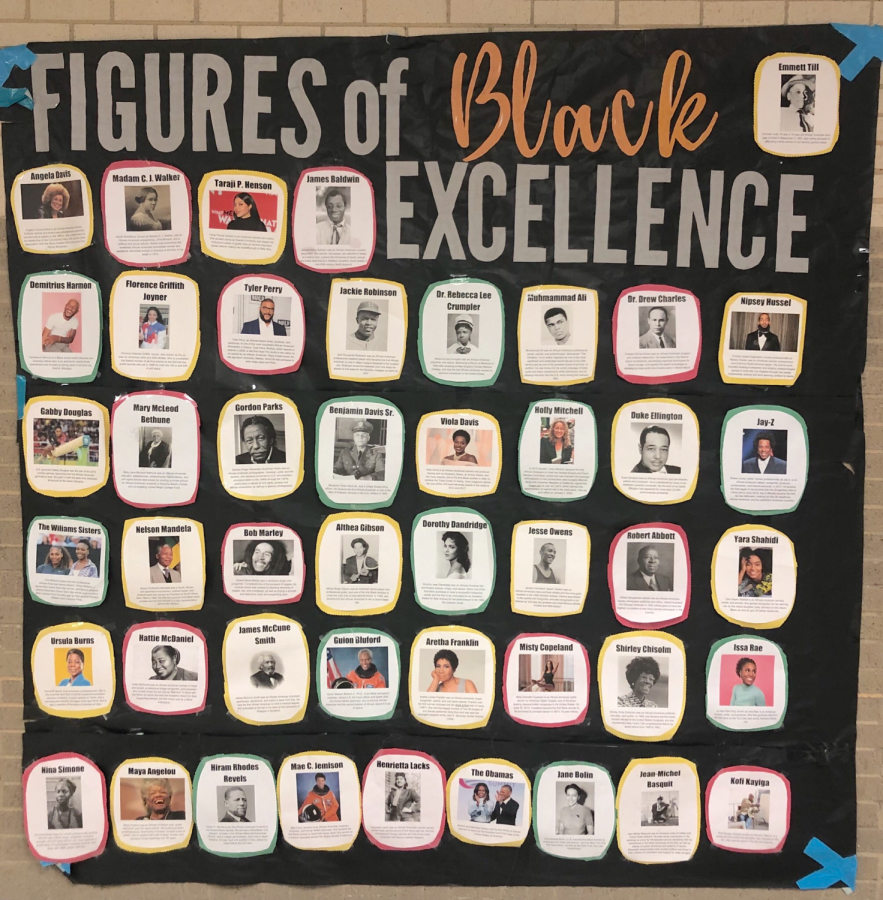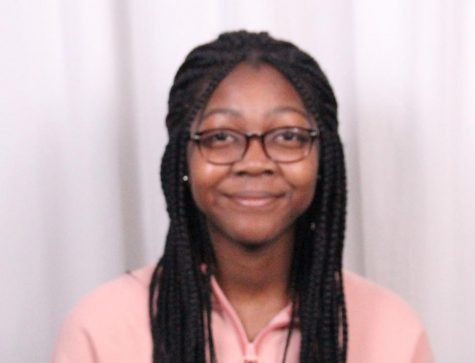Black History Month: New Figures of Influence
The African Student Organization made a bulletin board dedicated to both historical and modern figures of Black History.
From Martin Luther King Jr’s “I Have a Dream” speech to Rosa Parks’ famous Montgomery bus boycott, African American’s have been recognized for their influence in America. The month of February is set aside for Black History Month: A time when black figures and events are recognized. While it is important to praise these older figures, it can get a little redundant. For this reason, people may also want to be educated about the modern figures of this time, who they can relate to more.
With America’s long history of racism towards African-Americans, art teacher Chamillia Hervey says that this month of celebration is necessary so that the significant contributions made from black people is not overlooked or ignored.
“I think if Black History Month did not exist, then there probably wouldn’t be a dedicated time to talk about the history of black culture in America. The whole reason for the month was so that people have the opportunity to talk about it, because if not, it probably wouldn’t even be referenced through out the year,” said Hervey.
Each February, to acknowledge Black History Month, Lake Ridge students make announcements about black history figures’ impacts with the goal of educating the student body. Senior and President of the African Student Organization, Taylor Nelson, believed that this concept is not effective enough, and wanted to add a visual aspect to Black History Month at the school.
“Lake Ridge hasn’t really had much of a history of doing any influential things for Black History Month, so we were trying to find different ways to make sure that our voices could be heard and that we actually did something more than announcements that kids don’t listen to. We came up with this idea to do a gigantic bulletin board and put it on the second floor because that’s where a lot of the traffic in the school is,” said Nelson.
Part of Black History Month is celebrating the history of specific African American leaders and their lasting impact on America. While doing so, the light is mostly shed on the people from many decades ago. Because of this reason, Nelson said she wanted the bulletin board to be an even mix of old and new figures, due to the fact that young people can be inspired by people they recognize from both this generation and the older ones.
“When we say Black History Month, we always think history, so I had my club members submit one historical figure and one modern-day figure because there are a lot of figures today that are making history right now that we don’t recognize because we are living in it. When you think about it, they’re making history. Barack Obama is alive and he was the first African American president, so in a couple of years, he’ll be in our history books,” said Nelson. “I didn’t want people to feel like black history had to be boring or always the same. I wanted the members to have some modern day figures that they really appreciated and the our generation can relate to.”
While the popular figures of black history are constantly taught, Hervey says that there are more than just the well-known ones that have also played a big role.
“We typically think about the ones who have made civil rights impact, Like Martin Luther King, Malcolm X, Rosa Parks, Harriet Tubman: the classics that people typically talk about. But, there are many others that are unnamed that are not necessarily famously known,” said Hervey.
Similarly to Nelson, Hervey acknowledges that it will always be necessary to remember the people who helped pave the way for racial growth in the United States.
“I like to learn about people who are current as well because I think that’s equally important. I still think it’s important to look to the past. You have to know where you come from to know where you’re going,” said Hervey. “We have a lot of ground to cover when it comes to race relations here in the U.S. In the current climate, we can really notice inferences of where growth is needed, and there are people who are currently trying to change that culture as well.”
African American Studies is a class being taught at Lake Ridge for the first time this. The class focuses on the origin and power of African Americans starting from ancient history to the modern era. Heather Willson, the class advisor, explains how she implements all kinds of figures into her teachings.
“I have not been given a particular list of people to cover. That would have been nice and easy, but it also would have been very exclusive. Pop culture only identifies certain key individuals and they kind of don’t look at all the unsung heroes,” said Willson. “What we’re doing is we have topics and there are going to be the key leaders of each one of those topics. The students are also telling me other people they are interested in. If they are applicable to that, we include them.”
This Day in History is a link on History.com that informs people of events that happened years ago for each day of the year. Willson says that she uses this as another way to educate her students on new figures so that their actions can be analyzed.
“The African American Studies class does teach modern figures. We look at historical events everyday, like This Day in History. If there’s a person that’s modern who’s on that particular day, we will look at them that day. If it’s something in the news that we want to discuss, we talk about them.
With the same figures often reiterated every Black History Month, Willson says this is because people find it more convenient to teach about people they are more familiar with because they don’t have to do much further research.
“It’s a starting point for people. Other people go with it because they already know it. It’s comfortable, it’s a scaffolding point. It’s a springboard for them to go deeper,” said Willson.
Figures of African American culture do not have to be limited to the people from many years ago. As the world continues to get older, new people of influence will only rise.


